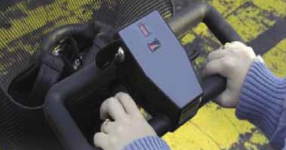A motorised wheelchair — also referred to as a gopher or mobility scooter — can be of great benefit to a person with a physical condition that limits their ability to walk long distances. However, there are safety issues to consider when driving one of these motorised wheelchairs on a footpath or road.
General requirements

If you already have one of these motorised wheelchairs or are considering purchasing one, you need to understand how its size (weight) and capacity determine where and how you may use it.
The Motor Vehicles Act 1959 and the Australian Road Rules prescribe the use of motorised wheelchairs to ensure the safety of the user, other pedestrians and road users.
Pedestrian use
Under the Australian Road Rules, a motorised wheelchair that is not capable of travelling at a speed greater than 10 kilometres per hour and is used by a person who is unable to walk or has difficulty walking is treated as a pedestrian.
Users of motorised wheelchairs must observe the same road rules applicable to all pedestrians, including:
- using the footpath or nature strip where one is available
- keeping to the far left or far right of a road where no footpath or nature strip is provided or is not practicable to use
- when moving forward, face oncoming traffic where practicable
- not travelling in bike lanes
- crossing a road at pedestrian lights and traffic lights
- not causing a traffic hazard or obstruction.
Many motorised wheelchairs do not have the capacity to travel faster than 10 kilometres per hour. However, if a motorised wheelchair can travel over 10 kilometres per hour, it may only be driven on a footpath if:
- it does not travel faster than 10 kilometres per hour
- it has an unladen mass not exceeding 170 kilograms
- the user has a physical condition with a reasonable need to use the motorised wheelchair.
Road use
A motorised wheelchair is exempt from the requirements of a driver’s licence, registration and insurance when driven on the road by a person who reasonably requires the use of the vehicle because of some physical infirmity. However, the exemption is subject to the following conditions:
- the vehicle is specifically designed and constructed, not merely adapted, for the transport of a person with some physical infirmity or disability
- it has seating for one person only
- is capable of short low-speed journeys only
- has an unladen mass not exceeding 250 kilograms.
Users of motorised wheelchairs with an unladen mass over 250 kilograms are not exempt from the requirement to hold a driver’s licence, vehicle registration, and insurance.
Safety tips
When using your motorised wheelchair on a footpath, it may not always be safe to travel at a speed of up to 10 kilometres per hour. You should reduce your speed according to the conditions of the footpath and other users.
When using your motorised wheelchair on the road, being seen by other road users is a significant difficulty faced by all road users due mainly to the size of the wheelchair relative to other vehicles.
Driving on the footpath is a much safer alternative. However, if you need to drive on or over a road, it is recommended that you do so safely by adhering to the following safety tips:
- Display a bicycle flag. These are available from most bicycle shops and will assist in making your vehicle more visible to other road users.
- It is not recommended that you drive on the road at night, but if you need to do so, you should wear bright clothing and display a white light at the front of the vehicle and a red light at the rear.
- Never assume that motorists have seen you and will give way. Use pedestrian crossings or cross at open areas with high visibility. If you must travel on the road, keep as close to the left or right as possible.
- Look for cars entering or exiting driveways and warn pedestrians as you approach. When travelling in congested areas, use the slowest speed possible. Always travel up and down ramps and inclines in as straight a line as possible to avoid tipping the vehicle over.
Insurance, injury and damage
Most household insurance policies cover legal liability for injury to other persons or damage to their property. However, it is unusual for insurance to include accidental damage to your wheelchair. If you require cover for damage to your motorised wheelchair, it is suggested that you seek advice from an insurance company.
Vehicle Standards reference: MR294.

